Local Worthies
A series of biographical notes on North East notables, past and present.
links to:
Dufton Scott Author and Humourist
Dr Walford Bodie Magician and Showman
Donald Dinnie Legendary Athlete
Thomas Edward Natural Historian
Thomas Blake Glover Victorian Industrialist
Francis Jamieson "Fruncie Markis" Musician and Athlete.
Mary Slessor Missionary in Nigeria
Jane Whyte Heroine of Aberdour
Peter Buchan Fisherman, Poet And Short Story Writer
Dufton Scott 1880-1944: A "Refined and Original" Scottish Humourist
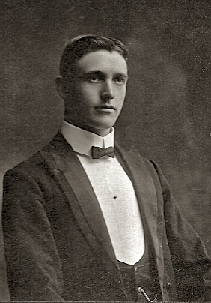 The son of George Dufton, a stone dyker, and his wife, Elizabeth, a seamstress, Robert Dufton Scott was born in Forgue, Aberdeenshire, in 1880. Although his ambition as a child was to be a great lion tamer (after witnessing an enthralling performance by "Sargano The Lion King" of The Bostock and Wombwell Menagerie) Dufton began his working life as an ironmonger in Huntly.
The son of George Dufton, a stone dyker, and his wife, Elizabeth, a seamstress, Robert Dufton Scott was born in Forgue, Aberdeenshire, in 1880. Although his ambition as a child was to be a great lion tamer (after witnessing an enthralling performance by "Sargano The Lion King" of The Bostock and Wombwell Menagerie) Dufton began his working life as an ironmonger in Huntly.
He didn't remain an ironmonger for long, however. Scott soon began acting in plays and sketches. By the age of 25, he had progressed to performing his own work to packed audiences all over Aberdeen and further afield.
In great demand as a comedian, Scott specialised in Doric recitations. In 1905 he entertained the Earl and Countess of Aberdeen at Haddo House. "Undoubtedly the most amusing items on the programme were the humorous sketches by Mr R D Scott who can produce merriment without vulgarity, and whose imitations of the Buchan and other Aberdeenshire dialects are decidedly clever" (Aberdeen Journal, 30.1.1905). By 1929 Dufton Scott was in such demand that the venues he performed at included Balmoral.
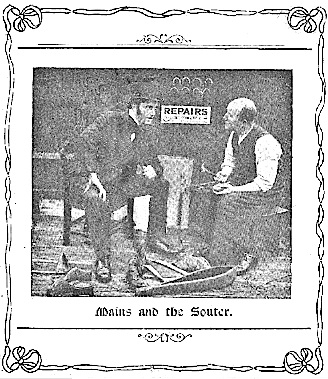 Scott in the lead role as "Mains" (the farmer who owned "Mains Farm") in the 1923 production of Gavin Greig's "Mains's Wooin'". In this scene Mains visits the souter (shoemaker) to seek advice on how to find a wife.
Scott in the lead role as "Mains" (the farmer who owned "Mains Farm") in the 1923 production of Gavin Greig's "Mains's Wooin'". In this scene Mains visits the souter (shoemaker) to seek advice on how to find a wife.
When the radio became more widely available in the 1920s Dufton Scott quickly became a favourite, hosting programmes such as "An Evenin in the Grieve's Hoose". Here Scott's stories were interspersed with songs from singers such as Tom Morrison. Scott's tales and sketches, besides being highly amusing, also describe the social make up of the early 20th century North East Scotland. The humour lies in the equality of speech between: master and hired help, men and women, lawyer and farm servant.
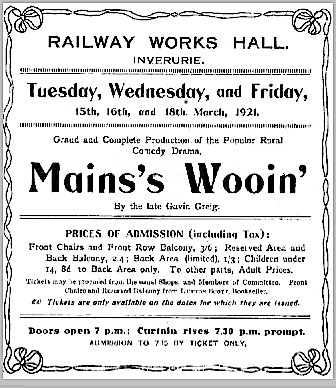 From a newspaper advertisement for Gavin Greig's "Mains's Wooin'", March, 1921. It states in the small print that tickets are available from Dufton Scott, Bookseller.
From a newspaper advertisement for Gavin Greig's "Mains's Wooin'", March, 1921. It states in the small print that tickets are available from Dufton Scott, Bookseller.
Besides working on the radio together, Scott collaborated with Morrison on many musical and dramatic productions on record and on stage, for example in Mains's Wooin' the comedy drama written by Gavin Greig.
Gavin Grieg, in the foreword to Scott's first publication (1913: Humorous Scotch Stories and Sketches) explains that "Mr Dufton Scott has long been recognised as a leading exponent of the native character and speech... these sketches are the outcome of close study and intimate knowledge of the characters delineated".
Subsequent editions of the book were issued having been updated with new material. (In the 1934 edition there are twelve stories, and by the 1953 edition it had risen to twenty stories) and, such were their popularity, they continued to be reprinted well into the 1950s. The sketches were, however, written to be performed and the record company Beltona were keen to record Scott reciting the stories. The advertising flyer declared that "Mr Scott is the acknowledged champion in typifying the manner and unconscious humour of Scottish country folk".
Beltona recorded many records in dialect, the most common being broad Aberdeenshire and Glasgow. "The speech used by Willie Kemp, George Morris, Dufton Scott, Bob Smith and others is very difficult for a non-Scot to understand. These records seem to have preserved for posterity patterns of speech and vocabulary that have all but disappeared". Source: Beltona Website. Even today Scott's recordings are still available to buy on CD. (See "Drama in a Barn" link below).
Scott was also particularly important in the support he gave to other Doric playwrights as a publisher and agent. One of these, Peter Grey, dedicated one of his plays to Scott. "To my friend, Dufton Scott, who has shown to his compatriots all the world over that the finest Scottish humour is clean and kindly" - which is a very complimentary comment for an author to give to an agent.
Dufton Scott died in 1944, in Inverurie, aged 64. The Kirk Session noted:
"His portrayal of the people of the North East of Scotland will remain as an accurate impression of all that is best, humourous and noblest in the lives of the people he loved and from whom he sprung".
Listen to Dufton recite a short extract from Drama in a Barn.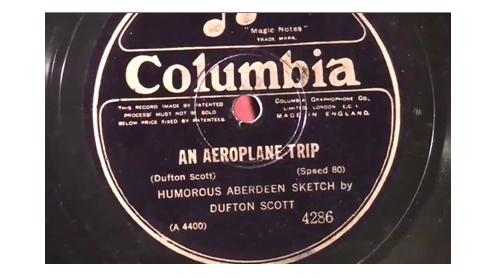 Listen to Dufton's Youtube story of An Aeroplane Trip. (Thanks to Andy Murrow for this link).
Listen to Dufton's Youtube story of An Aeroplane Trip. (Thanks to Andy Murrow for this link).
Written and researched by Katie Scott, Grand-daughter of Dufton Scott, November 2010.
Dr Walford Bodie MD 1869 - 1939: The Electrical Wizard of the North
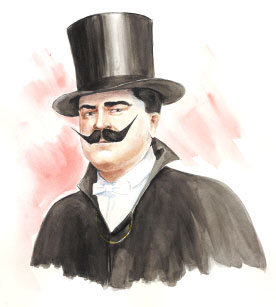 Born Samuel Murphy Bodie in Aberdeen, 1869, "Dr Walford Bodie MD" was
to become one of Scotland's best known Music Hall entertainers. His shows
included sleight of hand, hypnotism, electrical tricks and ventriloquism.
Born Samuel Murphy Bodie in Aberdeen, 1869, "Dr Walford Bodie MD" was
to become one of Scotland's best known Music Hall entertainers. His shows
included sleight of hand, hypnotism, electrical tricks and ventriloquism.
Bodie is remembered locally as a flamboyant and imposing character, always
smartly dressed with an immaculately groomed and waxed handle-bar moustache.
A master showman, he often started his performances with a demonstration of his electrical powers by passing 30,000 volts through his body. Unknown to his audience he used static electricity which produced a lot of sparks but was quite harmless. At one time he used an electric chair. In 1920 his friend, escapologist Harry Houdini, gave Bodie the chair which had been used for the first execution of its kind in the USA in 1890.
His use of the title MD was unpopular, especially with Glasgow's medical
students who pelted him with missiles and stopped one of his shows in the
city in 1909. Famously he always maintained that MD stood for "Merry
Devil."
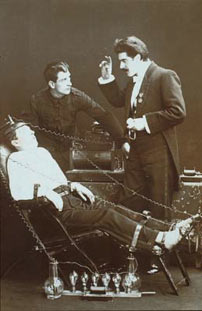 Bodie settled in Macduff after his marriage to a local girl, Jeannie Henry,
who he met at show in Banff when he was seventeen years old. He later built
a handsome family home, The Manor House, in Skene Street.
Bodie settled in Macduff after his marriage to a local girl, Jeannie Henry,
who he met at show in Banff when he was seventeen years old. He later built
a handsome family home, The Manor House, in Skene Street.
Jeannie and her sisters, Mary and Isabella, played major roles in Bodie's shows, Jeannie as "Princess Rubie," Mary as "Mystic Marie" and Isabella as "La Belle Electra." Mary and Isabella both died in their early twenties, Mary in 1906 at the Manor House, and Isabella in Glasgow in December 1919. Jeannie's younger sisters, Louie and Kitty, travelled with the shows as "musical conductresses."
Bodie with two assistants astonish their audience with electric magic. Scottish Theatre Archive
Bodie took a lively interest in the affairs of the town and had a public baths and swimming pool built for the use of its residents. "Bodie's Fountain", an unusual granite memorial to his daughter Jeannie who died at the age of 18 in 1909, stands in Duff Street, a few hundred yards from the family home. His eldest son, Albert, after a spell with a local firm of solicitors, followed in his father's footsteps as a member of the Royal Society of Illusionists. He was 26 years old when he died in 1915.
The show travelled far and wide and it was on a return voyage from India,
during World War I, that the ship they were on was torpedoed in the Mediterranean.
Bodie and Jeannie were separated after the ship sank and it was several
weeks before they were reunited.
During his extraordinary career Bodie amassed a small fortune. In addition
to the house he had built in Macduff in 1906 he owned a house boat on the
Thames and a theatrical club in London. The great showman was in his 70th
year when he died in Blackpool on the 18th October, 1939, while his show
was at the town's Olympia. GS
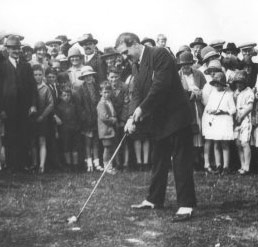 Royal Tarlair Golf Club, Macduff, was officially
opened by Bodie on 4th August, 1926. At the ceremony he said that, "With
its rare atmosphere and magnificent scenery it would become one of the
finest courses in the country and that one did not feel tired but actually
refreshed after a round."
Royal Tarlair Golf Club, Macduff, was officially
opened by Bodie on 4th August, 1926. At the ceremony he said that, "With
its rare atmosphere and magnificent scenery it would become one of the
finest courses in the country and that one did not feel tired but actually
refreshed after a round."
From an article in North East dialect, courtesy of The Ballater Eagle, 1998, Betty Allan recalls Walford Bodie's spectacular show at the Victoria Hall, Ballater, in 1935.
"The handsome Walford Bodie strode on stage in evenin' dress, silk hat and cape. Wi his black hair and glitterin dark een, he fair generated pouer and excitement himsel. A believe that some o the local worthies wis hypnotised that nicht, but A wis ower young tae tak in aa that. The sheer spectacle wis fit fair ca’d the feet fae me. Bricht lichts o every colour flashed roon the stage, blinkin on and aff sae quick it fair faized me. Blue, green, reid, yella, dazzlin white. Noo ye could see something or somebody - then there wis naething there at aa.
The highlicht cam at
the end o the programme. Blue spotlichts homed in on centre stage. A thin,
yalla-haired quine dressed in shimmerin silvery white cam in. In nae time
she wis hypnotised by the maestro and laid oot, stiff and straicht, een
closed, on a bench. Twa slim posts wis set up, each aboot the hicht o a
man. Then the quine wis lifted and set wi her heid on ae post and her heels
on the ither. She wis still stiff as a board. Foo could that be? Then the
post aneth her feet wis taen awa! A couldna believe A wis seein this. There
she floatit Still she bade rigid, her heid restin on the single slim post
and her body at richt angles tae it, like a railway signal. The finale
wis fin Bodie took awa the post fae aneth her heid! There she floatit under
the flickerin steel-blue lichts, rigid, on thin air, held up by naething
at aa!
A can see it aa as clear noo as on that nicht in Ballater’s Victoria
Hall in 1935.
A canna mind foo she wis brocht back tae normality, but A mind she took
a bow amid thunderin applause, and walked aff the stage as fleet as ye
like.
We spoke aboot Walford Bodie for lang aifter that, and A still think o
him wi a lot o respeck. We thocht then that the quine had some wey or ither
been electrocuted, but of course the electrical bittie o it micht hae been
jist the hokum o a consummate showman.
Bodie impressed us as naebody else had ivver deen. He brocht tae oor sheltered, quate village life the thrill o the unknown. Here wis something even oor ain big fowk didna understand! Wow! And we had been privileged tae see it! A still feel privileged. Some fowk ca’d Walford Bodie a charlatan, and some a miracle healer. There’s nae doot he wis a byornar [extraordinary] kind o a mannie. He must hae been mair nor sixty years aal that nicht in Ballater, and his ‘beautiful lady assistant’ wis maist likely his young second wife, Florrie Robertshaw. The quine best-kent as his subject for the ‘illusion of levitation’ wis a relation ca’ed ‘La Belle Electra’ and she toured Britain wi him for years. It wis a faimly show and maist o the artistes were related tae Bodie and his first wife Jean. Bodie died in 1939 and wis beeried in the faimly grave at Macduff.
For me, as for mony anither that fell under his spell, he remains 'THE GREAT AND ONLY WALFORD BODIE, ELECTRICAL WIZARD OF THE NORTH.' The toon o Macduff should be prood o him."
Information sources include: The Banffshire Journal, October 1939; Macduff and its Harbour 1783-1983; Old Banff and Macduff, Alan Cooper, 1999.
Donald Dinnie 1837 - 1916: Scotland's Greatest Athlete
 Born in Balnacriag, near Aboyne, Donald Dinnie was a legend of the nineteenth
century Highland Games, regarded by many as Scotland’s greatest ever
athlete.
Born in Balnacriag, near Aboyne, Donald Dinnie was a legend of the nineteenth
century Highland Games, regarded by many as Scotland’s greatest ever
athlete.
A stonemason by trade, he became a professional athlete in his late twenties,
winning his last prize in the Highland Games at the age of 76! Having toured
Australia, America and South Africa, Dinnie retired in 1913 after winning
eleven thousand prizes and twenty-six thousand pounds in prize money. Many
of his medals are now missing, perhaps having been sold when he fell on
hard times towards the end of his life. Some are held in a collection by
Aberdeen Art Gallery & Museums, the earliest dated 1859 for "heavy" events
at Glenisla and Perth, and the latest dated 1884 for Club Swinging in Brisbane,
Australia.
His classic "around the head" hammer throwing style, a style
of throwing he developed in the 1850s, was adopted by many of his competitors
and is still used by toady's games athletes.
Medals!
A studio photograph of Dinnie taken during his trip to Australia and
New Zealand in 1884.
Adding to Dinnie’s fame is an extraordinary event which took place
over the River Dee during his teenage years. In assisting his father to
repair the Potarch Bridge, near Kincardine O’Neal, Dinnie displayed
super human strength by carrying two huge boulders totalling 785lbs in
weight across the bridge. The ‘Dinnie Steens’ are now legendary.
Nobody has ever equalled this amazing feat without the aid of a harness.
Although today the games are more diverse, the athletics and weight throwing
competitions remain at the heart of the games. GDA
Thomas Edward 1814 - 1886: Natural Historian
 A small blue plaque on the wall of a house on the Low Shore, Banff, marks
what was once the home of the late Thomas Edward, his wife Sophia and their
eleven children. A shoemaker by trade, Edward had a life long interest
in natural history, some might say an obsession, which was finally rewarded
by a pension of "£50 per annum," granted to him by Queen
Victoria.
A small blue plaque on the wall of a house on the Low Shore, Banff, marks
what was once the home of the late Thomas Edward, his wife Sophia and their
eleven children. A shoemaker by trade, Edward had a life long interest
in natural history, some might say an obsession, which was finally rewarded
by a pension of "£50 per annum," granted to him by Queen
Victoria.
Thomas Edward
Engraved by Charles Roberts after a drawing by George Reid, RSA
Thomas Edward was born on Christmas Day, 1814, in Gosport on England's
south coast, the son of John Edward, a soldier with the Fifeshire Militia
who at the time was on duty there, watching over prisoners from the Napoleonic
wars. His mother, Margaret Mitchell, was a native of Aberdeen. After the
war the family returned to Fifeshire where John went back to his trade
as a cotton loom weaver. After a short time in the village of Kettle the
family moved to Aberdeen.
Young Tom's interest in "beasties" began at a very early age,
an interest which saw him dismissed from three local schools by the age
of six. His habit of taking rats and snakes he had trapped in the countryside
around the city was unacceptable. And so (at the age of six!) Tom found
his first job, assisting a "tobacco spinner" in an Aberdeen factory.
In later years he signed on as an apprentice shoemaker, the trade that
would be his main source of income for the rest of his life.
At the age of twenty he moved to Banff where he continued his trade. His plan was to save enough money to emigrate to America but, after meeting Sophia Reid, a lass from the farm of Boyndie, just outside the town, he married and settled in the town. By now he was a dedicated natural historian, spending all his spare time searching the coastline from Portsoy to Pennan for specimens great and small. With a desire to record and study his finds he taught himself to read and write and eventually became an Associate of the Linnean Society.
His life was fraught with setbacks as he struggled to balance his enthusiasm
for wildlife study with the need to support his wife and growing family.
He tried to make money from taxidermy, a skill he had taught himself, but
found his specimens hard to sell and on many occasions returned home from
exhausting trips, on foot, penniless. After a poorly attended exhibition
of his taxidermy in Aberdeen, Dr Macgillivary, Professor of Natural History
in Marischal College, remarked "The people of Aberdeen were not yet
prepared for such an exhibition, especially as it had been the work of
a poor man. He had come several centuries too soon."
In 1852 he was appointed curator of Banff Museum with a salary of two guineas
a year which rose to thirteen pounds after the Corporation took over the
building in 1866.
In Edward's biography, "Life of a Scotch Naturalist" written
by Samuel Smiles and published in 1876, there are numerous accounts of
his adventures on the precarious cliff tops and rocky shores of the Moray
Firth. On one visit to Gamrie he fell from a ledge at Mohr Head, an accident
which led to the discovery of a rare Spiny Shark, lying dead at the bottom
of the cliff. It is interesting to compare his notes on local fauna with
the present day. He noted on one occasion that hundreds of Little Auks
had been blown by a gale onto the coast east of Banff. These birds, the
smallest of the auks, are long gone from our shores. Fulmars, however,
a common sight in the area now, were rarely, if ever, seen by Thomas Edward.
Smiles' biography brought Edward to the attention of Queen Victoria who
was so impressed by the man and his work that she awarded him a pension.
Thomas Edward died in 1886, survived by his wife and eleven children. GS
Thomas Blake Glover 1838 - 1911: "The Scottish Samurie"
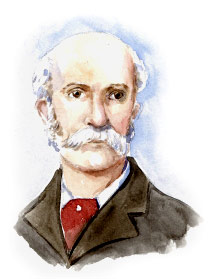 The son of a Fraserburgh coastguard, Thomas Blake Glover was destined
to become one of Victorian Scotland's most successful and influential industrialists.
He was born at 15 Commerce Street, Fraserburgh on June 6, 1838 and spent
his early childhood in the North East fishing town. Glover was thirteen
years old when his family settled in Bridge of Don, Aberdeen, and it was
there that he began working for a trading company and travelling the world.
The son of a Fraserburgh coastguard, Thomas Blake Glover was destined
to become one of Victorian Scotland's most successful and influential industrialists.
He was born at 15 Commerce Street, Fraserburgh on June 6, 1838 and spent
his early childhood in the North East fishing town. Glover was thirteen
years old when his family settled in Bridge of Don, Aberdeen, and it was
there that he began working for a trading company and travelling the world.
Thomas Blake Glover
1838 - 1911
He became a successful merchant, trading in ships and weapons in Japan during the 1860's and was responsible for commissioning three warships for the Japanese navy from Aberdeen shipyards. He later established his own shipbuilding business which later grew into the world famous Mitsubishi Company.
Glover introduced a number innovations to his adopted country including the railways and mechanised coal mining. He also established a brewing company which remains today Japan's biggest beer producer. It is said that his marriage to the daughter of a samurai inspired Puccini's Madame Butterfly.
Though the achievements of the coastguard's son are surprisingly little known in his native North East Scotland, in Japan Glover is celebrated as a national hero. His house in Nagasaki is one of Japan's most popular tourist attractions with nearly 2 million visitors every year. In contrast, his birth place didn't fare so well. During World War II a bomb hit Commerce Street and razed his old family home to rubble.
Glover died in Japan in 1911 at the age of 73.
Francis Jamieson 1823 - 1903: Musician and Athlete of Clochforbie
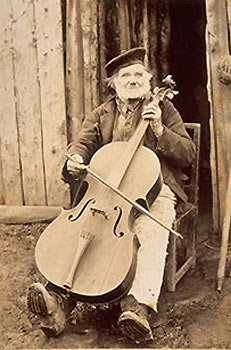 Francis Jamieson was born the son of William Jamieson and Ann Urquhart
in the Parish of Monquhitter, 18th July, 1823. He was known familiarly
throughout the north east as "Fruncie Markis," the "Markis" or "Marquis" came
about because some said he resembled the Marquis Of Huntly.
Francis Jamieson was born the son of William Jamieson and Ann Urquhart
in the Parish of Monquhitter, 18th July, 1823. He was known familiarly
throughout the north east as "Fruncie Markis," the "Markis" or "Marquis" came
about because some said he resembled the Marquis Of Huntly.
A superb musician and athlete, he was born and lived all his life in a croft, dry stone built with a thatched roof of heather and grass on the moorland Braes of Clochforbie, near New Byth village in the north of Aberdeenshire.
Cello and Tackety Boots
"Fruncie" with the cello he took to local dances strapped on the back of a horse!
A singularly unique character, Francis could match any athlete on the field in shot-putt, hammer throwing or weight-slinging, but his prowess was in running.
It was said that, "The Jamieson family clowned its way through Buchan for half a century". This is not a disparaging remark as some of Francis’s exploits were spoken with fondness and admiration – on one occasion he was said to have won a race at the Badenscoth games, near Rothienorman, and ran through the night to compete in the Elgin games, some sixty or so miles distant.
Francis was often compared with his supposed nephew, Joseph Sim, the "Wonderful Boy" of New Byth, himself a skilful fiddler, who had his own dance band and with whom Francis often played at dances in and around Buchan. Joseph was also reckoned to be a fine athlete and so features in some of the, perhaps, apocryphal stories – Francis and Joseph sometimes being substituted for each other in the re-telling.
Not long after the opening of the Buchan railway line Francis was challenged to race the steam train from Aikey Brae, near Mintlaw, famous for the traveller’s horse fair, to Maud, the next village on the line. A gallant attempt failed and when the engine steamed into the station, followed by Francis, he shook his fist and shouted, "Ye muckle black bugger! Gin I hid ye on the Moss o’ Byth I’d hae gaen ye a reed face!"
Francis Jamieson’s skills on the field were matched with his dexterity as a musician – "A master with the cello, an angel with the fiddle, and a devil with the oxter pipes." (ROBERT SMITH: “BUCHAN, LAND OF PLENTY” 1996)
There is a story that "Fruncie" won his small (oxter) pipes in a competition and thereafter learned to play along with his cherished bass fiddle and cello. The “Oxter Pipes” – "Oxter" being the Aberdeenshire word for armpits where the bellows rest and are pumped by a sideways action of the arm – are in a family of Small Pipes each with their own distinctive geographical names; the Northumbrian Pipes, the Irish Uilleann Pipes, and the Lowland Pipes of the Borders, all deriving from the French Musette Du Cour, a bellows blown Small Pipe, said to be the instrument of Charles Edward Stuart – "Bonnie Prince Charlie".
It is likely that "Fruncie Markis’s" abilities stretched from athletics and playing his Small Pipes (and cello and fiddle), to dancing, given his reputation as a real character. His appetite, amongst other things, preceded him in reputation and he was known to have eaten a whole "bubbly jock" (turkey) in one sitting. Perhaps the exercise on the track and dance floor was requisite in training for the reels, strathspeys and jigs he entertained his audience with on his pipes.
Francis Jamieson died on the 19th September 1903 in poverty, still in his "thackit stane hoosie" on the Braes of Clochforbie. He was buried in the New Cemetery at Byth. GDA
Mary Slessor 1848 - 1915: Missionary in Nigeria
 Mary
Slessor was Born in Aberdeen in 1848, at Mutton Brae. Her father was a
souter (shoemaker) who earned little and spent much of his wages on drink.
The family lived in a slum, long since cleared away, and were always underfed.
Of the six children few reached adulthood and Mary was the only one to
survive into old age.
Mary
Slessor was Born in Aberdeen in 1848, at Mutton Brae. Her father was a
souter (shoemaker) who earned little and spent much of his wages on drink.
The family lived in a slum, long since cleared away, and were always underfed.
Of the six children few reached adulthood and Mary was the only one to
survive into old age.
Mary Slessor
So far, the only woman to have appeared on a Scottish bank note
Her mother, a strong believer in the Christian faith, had hoped that her eldest son, Robert, might become a missionary but he died prematurely at the age of sixteen. At that same time Mary's father was sacked from the shoe factory and the family headed south to Dundee in hope of a new life. Though only ten years old and still at school, Mary found a part time job in a local jute mill. When she left school she continued to work at the mill, long, grulling, twelve hour shifts, six days a week and it was during this time that Mary read and studied the books that helped her decide her destiny. She learned that in 1848 a mission had been set up at Calabar on the Nigerian coast, at the very centre of the African slave trade. What fascinated her most of all was that the mission had been established by a Dr Ferguson who first went to Nigeria as surgeon aboard a slave ship.
When Dr Ferguson's ship was wrecked on the Nigerian coast the crew almost starved to death before they were found by local tribesmen. White-men, especially slave traders, were understandably unpopular in such regions and the crew were convinced that they would be killed. But, contrary to the sailors' presumptions, the men were fed and nursed back to health before the tribal chief helped them find a passage home.
Her plans to go to Calabar were held up for several years after her father died and Mary found herself responsible for her younger sisters and ailing mother. She was 26 years old when she finally left for Nigeria, sailing on the "Ethiopia" of the African Steamship Line, to start a new life at the Calabar Christian Mission. The tribes of that region she found to have traditions that were cruel beyond belief. For instance, they slaughtered the slaves and wives of important men when they died and also killed twins at birth believing that one of the children was evil! She had not been there long when she witnessed a slave being fed to a crocodile in hope that the sacrifice would bring a good season's fishing. These were things were typical of the many barbaric traditions that Mary was determined to eradicate.
Through the years Mary made much progress in her work and eventually won the trust all around her. By the time of her death in 1915 she had achieved many of her goals. Twins were no longer seen as evil and slaves were no longer fed to crocodiles as acts of sacrifice. After suffering arthritis for many years, Mary died at Duke Town. At her burial hundreds wept and moaned as the great little woman was laid to rest. GS
Jane Whyte 1844 - 1918: Aberdour Heroine
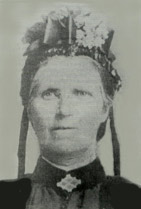 A few yards from the shore of Aberdour Bay stood Waulkmill, the home of
John Whyte, foreman of nearby Bankhead Farm, his wife Jane and their nine
children. Very little remains today of the building which was home to a
woman whose heroism and bravery must never be forgotten.
A few yards from the shore of Aberdour Bay stood Waulkmill, the home of
John Whyte, foreman of nearby Bankhead Farm, his wife Jane and their nine
children. Very little remains today of the building which was home to a
woman whose heroism and bravery must never be forgotten.
On the evening of October 27th, 1884, the Dundee steamer "William
Hope" was homeward bound through the Moray Firth as a stiff breeze
announced the coming of a storm. Under Captain Golden, the vessel had on
many occasions proved her worth and there was no real cause for alarm,
but, when her engines failed as she passed Troup Head, the crew could do
nothing to stop the ship's drift towards the rocky shores of Aberdour Bay.
The next morning, after her husband had left for work, Jane went down to
the shore with Jock her collie. A few yards off she could see a half sunken
ship in the raging surf. Men clung to the masts and she could hear their
cries for help. She stood in shock for a moment. What could she do to help
the stranded men? One of the crewmen threw a rope in her direction and,
ignoring the cold and obvious danger, she made for the water, forcing her
way through the waves until she was in reach of the rope which she somehow
managed to tie around her waist as she scrambled back to the shore. One
by one the men made their way along the rope until all fifteen of the stricken
crewmen were safe ashore.
She took them home, gave them dry clothes and fed them. The following morning the crew made there way on foot to Fraserburgh where they took the train south to Dundee.
Jane Whyte's courageous act was awarded by the Shipwrecked Mariners Society and the Royal National Lifeboat Institute. The following notice appeared in the Fraserburgh Herald in December 1884:
"At a meeting of the Committee of the Royal National Lifeboat Institute for the preservation of the loss of life from shipwreck, held in London on the 4th day of December, 1884, the following minute was ordered to be recorded in the books of the Society and to be communicated to Andrew Terras Esq, Fraserburgh. Resolved that the silver medal of the RNLI and £10 be presented to Mrs Whyte in recognition of her very brave service in saving by means of rope thrown from the vessel, the crew of the steamer "William Hope" of Dundee in Aberdour Bay in a gale and heavy sea on 28th October, 1884. Signed Edward Birkbeck, Chairman and Charles Dibdin, Secretary."
GS
Information sources include: Aberdour Shore, Mary Michie, 1986; The Fraserburgh Herald, December 1884
Peter Buchan 1917 - 1991: Fisherman, Poet And Short Story Writer
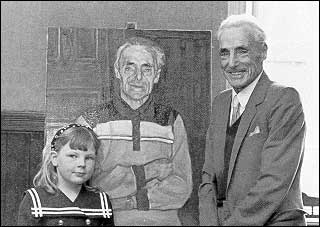
In March 1991 the North East Scotland Museums Service commissioned a portrait by the Edinburgh artist Michael Knowles. Unveiled on June 17th 1991, it now hangs in the entrance hall of the Arbuthnot Museum, St. Peter Street, Peterhead.
Peter Buchan was born in Peterhead, Aberdeenshire, in 1917. A fisherman's son, Peter was educated at Peterhead Academy until he left school to "go to sea" at the age of 16. He married Agnes Cowe, a local "quine" in 1940, and later had two daughters, Agnes and Alison.
Peter's first collection of poems, "Mount Pleasant" was published in 1961. He then began to write short stories portraying the middle ground in fisher life which had formerly been portrayed at the two extremes of either drunkenness or religious fanaticism and he found a large readership for his work both at home and abroad.
He broadcast regularly on radio and was interviewed several times on television following publications of books. He was vice-president of the Buchan Heritage Society from 1988-90, then Patron until his death. He also edited five editions of the society's magazine "Heirskip" (inheritance) from 1987-91.
For many years Peter Buchan was the voice of Scotland's North East fisher community, dispensing wisdom and good humour in his poems and short stories. A great interest in people provided the main source of his inspiration to write. "Human naitur" he called it, and his observations around his home town and further afield, in the fishing ports from Stornaway to Yarmouth, resulted in many marvellous character studies.
He was unique, writing mostly in his native North East Dialect, exactly as he spoke it every day of his life. He was one of the caretakers of the rich beautiful language and used it with great skill when describing the lives of the fisher folk.
Peter died in Peterhead on 12th December 1991.

